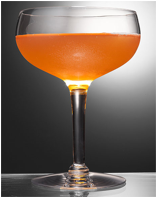 The New Esquire Cocktail
The New Esquire CocktailHundreds of hours of research later, a foolproof, well-balanced, tequila-friendly (and gin-friendly and whiskey-friendly) template for making drinks
By David Wondrich
We have often (and recently) praised the balanced, savory perfection of the original daiquiri, an elemental mixture produced by stirring a scant teaspoon of sugar with half an ounce of lime juice, adding a couple ounces of flavorful white rum and a lot of ice and shaking as if your life depended on it. All well and good, but sometimes you don't want rum. Unfortunately, when executed with whiskey, gin, brandy, or whatever else is in the back of the liquor cabinet, that same formula somehow seems to be lacking. Not that there's anything wrong with a plain whiskey sour, gin sour, or back-of-the-cabinet sour. But without rum's peculiar funk, it's just a little dull.
It's not just us saying that, either. Paging through our collection of bartenders' bibles here at the Esquire Institute for Advanced Research in Mixology, we found a host of devices to spice such things up. It can be as left field as floating a layer of red wine on top of a whiskey sour (yielding a New York sour) or adding the white of a raw egg, or as fancy as stretching out the drink with a healthy pour of champagne. (Make it with gin or, some say, cognac and it's a French 75.) Or it can be as simple as replacing the sugar with a liqueur, thus yielding, for example, the margarita — tequila, lime juice, and Cointreau. With cognac and lemon juice, that's a sidecar; with gin, lemon juice, and egg white, it's a White Lady. These expedients are all excellent, although they do share the defect of making an already boozy drink even boozier — if you consider that a defect.
Never satisfied with the status quo, we kicked the problem downstairs to some of the junior chemists at the Institute, and they came up with their own solution, a variation on the margarita/sidecar/White Lady formula so simple and yet effective that it can be used with almost any combination of spirit, citrus, and liqueur. It hinges on a not-so-secret ingredient by the name of Aperol ($22), a low-proof (11 percent alcohol) orange-red Italian aperitif flavored with various roots, herbs, and spices that has been described as "Campari with training wheels" — less bitter, less red, less alcohol. Amid all that less, Aperol has one big more: It has an uncanny way of bridging the gaps between liquor, liqueur, and citrus juice, smoothing the edges of each and filling in the gaps with little herbal accents. Mix one part each of Aperol, lemon or lime juice, and liqueur (okay, not Baileys or anything too dessertish) and three parts liquor (gin and tequila are particularly good here) and you'll usually end up with a subtle, toothsome, and mysterious cocktail that's not too sweet, not too dry, and utterly insinuating. It doesn't work with everything: Johnnie Walker Black and green Chartreuse were a little challenging, but Old Fitzgerald and Southern Comfort made for a surprisingly bright and juicy cocktail, and Tanqueray and Drambuie — well, we had three of those.
The Equation
Shake well with plenty of ice:
